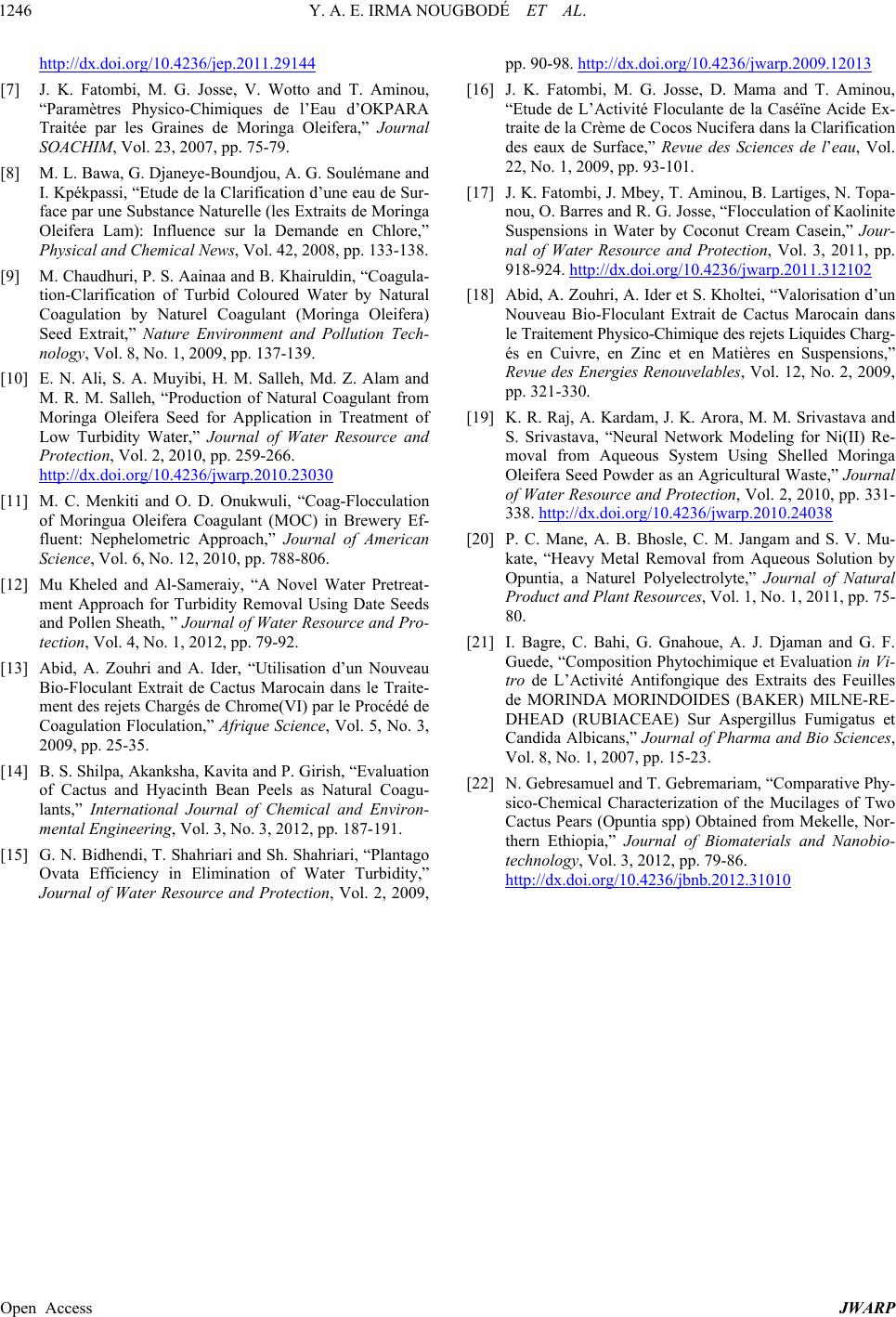
Y. A. E. IRMA NOUGBODÉ ET AL.
Open Access JWARP
1246
http://dx.doi.org/10.4236/jep.2011.29144
[7] J. K. Fatombi, M. G. Josse, V. Wotto and T. Aminou,
“Paramètres Physico-Chimiques de l’Eau d’OKPARA
Traitée par les Graines de Moringa Oleifera,” Journal
SOACHIM, Vol. 23, 2007, pp. 75-79.
[8] M. L. Bawa, G. Djaneye-Boundjou, A. G. Soulémane and
I. Kpékpassi, “Etude de la Clarification d’une eau de Sur-
face par une Substance Naturelle (les Extraits de Moringa
Oleifera Lam): Influence sur la Demande en Chlore,”
Physical and Chemical News, Vol. 42, 2008, pp. 133-138.
[9] M. Chaudhuri, P. S. Aainaa and B. Khairuldin, “Coagula-
tion-Clarification of Turbid Coloured Water by Natural
Coagulation by Naturel Coagulant (Moringa Oleifera)
Seed Extrait,” Nature Environment and Pollution Tech-
nology, Vol. 8, No. 1, 2009, pp. 137-139.
[10] E. N. Ali, S. A. Muyibi, H. M. Salleh, Md. Z. Alam and
M. R. M. Salleh, “Production of Natural Coagulant from
Moringa Oleifera Seed for Application in Treatment of
Low Turbidity Water,” Journal of Water Resource and
Protection, Vol. 2, 2010, pp. 259-266.
http://dx.doi.org/10.4236/jwarp.2010.23030
[11] M. C. Menkiti and O. D. Onukwuli, “Coag-Flocculation
of Moringua Oleifera Coagulant (MOC) in Brewery Ef-
fluent: Nephelometric Approach,” Journal of American
Science, Vol. 6, No. 12, 2010, pp. 788-806.
[12] Mu Kheled and Al-Sameraiy, “A Novel Water Pretreat-
ment Approach for Turbidity Removal Using Date Seeds
and Pollen Sheath, ” Journal of Water Resource and Pro-
tection, Vol. 4, No. 1, 2012, pp. 79-92.
[13] Abid, A. Zouhri and A. Ider, “Utilisation d’un Nouveau
Bio-Floculant Extrait de Cactus Marocain dans le Traite-
ment des rejets Chargés de Chrome(VI) par le Procédé de
Coagulation Floculation,” Afrique Science, Vol. 5, No. 3,
2009, pp. 25-35.
[14] B. S. Shilpa, Akanksha, Kavita and P. Girish, “Evaluation
of Cactus and Hyacinth Bean Peels as Natural Coagu-
lants,” International Journal of Chemical and Environ-
mental Engineering, Vol. 3, No. 3, 2012, pp. 187-191.
[15] G. N. Bidhendi, T. Shahriari and Sh. Shahriari, “Plantago
Ovata Efficiency in Elimination of Water Turbidity,”
Journal of Water Resource and Protection, Vol. 2, 2009,
pp. 90-98. http://dx.doi.org/10.4236/jwarp.2009.12013
[16] J. K. Fatombi, M. G. Josse, D. Mama and T. Aminou,
“Etude de L’Activité Floculante de la Caséïne Acide Ex-
traite de la Crème de Cocos Nucifera dans la Clarification
des eaux de Surface,” Revue des Sciences de l’eau, Vol.
22, No. 1, 2009, pp. 93-101.
[17] J. K. Fatombi, J. Mbey, T. Aminou, B. Lartiges, N. Topa-
nou, O. Barres and R. G. Josse, “Flocculation of Kaolinite
Suspensions in Water by Coconut Cream Casein,” Jour-
nal of Water Resource and Protection, Vol. 3, 2011, pp.
918-924. http://dx.doi.org/10.4236/jwarp.2011.312102
[18] Abid, A. Zouhri, A. Ider et S. Kholtei, “Valorisation d’un
Nouveau Bio-Floculant Extrait de Cactus Marocain dans
le Traitement Physico-Chimique des rejets Liquides Charg-
és en Cuivre, en Zinc et en Matières en Suspensions,”
Revue des Energies Renouvelables, Vol. 12, No. 2, 2009,
pp. 321-330.
[19] K. R. Raj, A. Kardam, J. K. Arora, M. M. Srivastava and
S. Srivastava, “Neural Network Modeling for Ni(II) Re-
moval from Aqueous System Using Shelled Moringa
Oleifera Seed Powder as an Agricultural Waste,” Journal
of Water Resource and Protection, Vol. 2, 2010, pp. 331-
338. http://dx.doi.org/10.4236/jwarp.2010.24038
[20] P. C. Mane, A. B. Bhosle, C. M. Jangam and S. V. Mu-
kate, “Heavy Metal Removal from Aqueous Solution by
Opuntia, a Naturel Polyelectrolyte,” Journal of Natural
Product and Plant Resources, Vol. 1, No. 1, 2011, pp. 75-
80.
[21] I. Bagre, C. Bahi, G. Gnahoue, A. J. Djaman and G. F.
Guede, “Composition Phytochimique et Evaluation in Vi-
tro de L’Activité Antifongique des Extraits des Feuilles
de MORINDA MORINDOIDES (BAKER) MILNE-RE-
DHEAD (RUBIACEAE) Sur Aspergillus Fumigatus et
Candida Albicans,” Journal of Pharma and Bio Sciences,
Vol. 8, No. 1, 2007, pp. 15-23.
[22] N. Gebresamuel and T. Gebremariam, “Comparative Phy-
sico-Chemical Characterization of the Mucilages of Two
Cactus Pears (Opuntia spp) Obtained from Mekelle, Nor-
thern Ethiopia,” Journal of Biomaterials and Nanobio-
technology, Vol. 3, 2012, pp. 79-86.
http://dx.doi.org/10.4236/jbnb.2012.31010